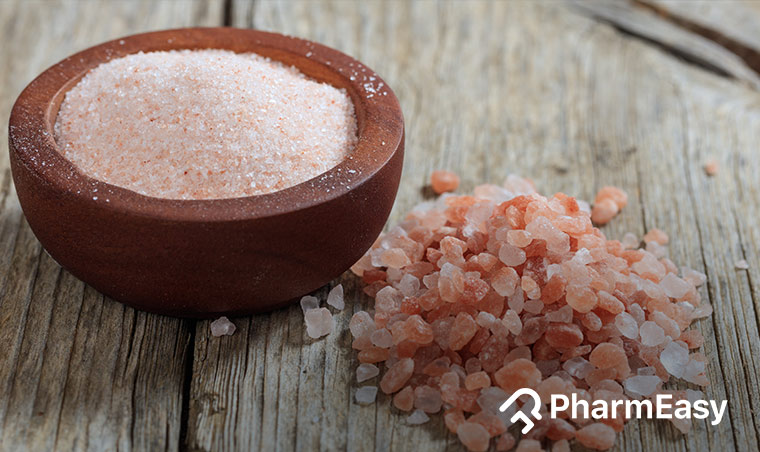Pink Himalayan Salt: Uses, Benefits, Side Effects, Precautions & More!
By Dr Rajeev Singh +2 more

Get,

to manage your symptom
Get your,


4 Cr+ families
benefitted

OTP sent to 9988776655



You’ve successfully subscribed to receive
doctor-approved tips on
Whatsapp

Get ready to feel your best.

Hi There,
Download the PharmEasy App now!!


Register to Avail the Offer
Send OTPBy continuing, you agree with our Privacy Policy and Terms and Conditions

Hi There,
Sign up on PharmEasy now!!
Trusted by 4 crore+ families

OTP sent to 9988776655



You have unlocked 25% off on medicines




Code: NU25
By Dr Rajeev Singh +2 more
Table of Contents
Himalayan pink salt is a naturally pink-coloured variety of salt mined in Pakistan near the Himalayan Mountains of South Asia. Pink Himalayan salt is mined like rock salt; but, it is technically sea salt. Salt is a nutrient that might play an important role in maintaining human health.
However, excess salt in our diet can lead to high blood pressure, heart disease, and stroke. Due to its health benefits, Himalayan pink salt is used as an alternative to table salt.. Pink Himalayan salt has superior mineral content compared to table or sea salt1. It contains lower sodium chloride compared to table salt.

Pink Himalayan salt has many essential minerals and elements1. However, many of these minerals are present in very small amounts and might not contribute to any health benefits.

Pink Himalayan salt is the purest variety of salt as it contains no chemicals or toxins. It possesses about 84 minerals that can be absorbed easily by the body due to their small molecular size. Ancient Greeks used pink Himalayan salt to clear airways and to improve breathing. Himalayan salt lamps are used to remove dust, pollen, smoke, and other contaminants that could increase the risk of respiratory problems.
Himalayan salt inhalers can help cleanse the respiratory system and may relieve symptoms of asthma, hay fever, and allergies. Salt might reduce symptoms of conditions like sinus infections and asthma2. You must consult a doctor for such conditions.

Pink Himalayan salt may enhance serotonin levels in your body. This chemical might help to reduce stress, boost energy and relieve depression. Pink Himalayan salt can help restore energy in your body. There is a lack of evidence for this benefit.

Due to its high mineral content, Himalayan pink salt may help you sleep well.. A diet low in sodium can lead to irregular and disturbed sleep patterns3. A hormone called cortisol is produced in response to stress. Cortisol can obstruct the flow of melatonin, which may help the sleep hormone. Pink Himalayan salt lamps and inhalers might promote peaceful sleep by reducing stress. Please consult your doctor for proper advice.

Pink Himalayan salt contains deepan (appetizing) and pachan (digestive) properties. These may help in solving digestive problems and prevent gas accumulation. Pink Himalayan salt can also help peristalsis (muscle contraction that moves food through the digestive tract). It helps regulate metabolism and promotes acid-alkaline balance. These benefits may need further studies to establish.

Pink Himalayan salt contains detoxifying properties and may help to remove toxins from the skin, and thus may have some effect on clean and soft skin. It may keep the skin hydrated which makes it appear young and fresh. One of the reasons for acne is an imbalance in the skin pH. Pink Himalayan salt can balance skin’s pH level and help with acne-free skin. Pink Himalayan salt may be helpful for skin conditions like eczema. However, you must consult with your Ayurvedic doctor or dermatologist before using any herb for your skin.

Himalayan pink salt can be helpful in weight loss without any major side effects. Using Himalayan salt soles is a popular way which may help in weight loss. The salt sole contains the essence of the salt. This sole can be prepared by leaving a handful of pink salt granules in a jug filled with water overnight and letting them dissolve.
Excess salt intake causes water retention inside the cells of our body. Unlike table salt, Himalayan salt crystals expel extra water from the cells. Pink himalayan salt may additionally enrich the body with minerals and nutrients.

Muscle cramps commonly occur due to magnesium deficiency. Pink Himalayan salt contains an adequate amount of magnesium and thus it may be effective in the management of muscle cramps. These benefits are not backed with sufficient scientific evidence; thus an advice from a qualified doctor is recommended.

Pink Himalayan salt might help improve blood circulation in the body. It may have some effect on regulating blood pressure levels and decreases the risk of heart attack.
Though studies show Himalayan pink salt benefits in various disease conditions, these studies are insufficient, and there is a need for further studies to establish the true extent of Himalayan salt (pink salt) benefits on human health.
According to some studies in Australia, pink salt found in those regions contains both nutrient and non-nutrient minerals. It includes nutrients like sodium, potassium, magnesium, calcium, iron, etc. The non-nutrients include aluminium, lead, mercury, etc. Even after processing, the presence of some impurities like lead, mercury and others can be observed1. Furthermore, to provide sufficient value of these nutrients, one needs to consume a higher amount of pink salt compared to table salt. Therefore, it is essential to check on which region of pink salt you are buying.
Dr. Rajeev Singh, BAMS
Himalayan salt is used in different ways depending on its use:
Many people also might use Himalayan pink salt as a substitute for bath salts.
Consuming too much salt can result in side effects. It is essential to keep all possible risks in mind and take salt in moderation. The possible Himalayan pink salt side effects are:
Excess salt intake can lead to high blood pressure and increase the risk of chronic kidney disease (CKD)4.
Consuming excess salt can result in excessive flushing out of calcium through urine. This might lead to osteoporosis5.
High blood pressure is the most common cause of heart disease. Excess salt intake leads to hypertension6.
This is a condition in which the sodium levels in the blood are too high. Hypernatremia produces serious health issues, out of which dehydration is a significant one. When sodium in the blood is very high, the body tries to set it right by moving water out of the cells into the bloodstream. Excess water is flushed out via urine along with other essential salts, leading to dehydration6.
Fluids may accumulate in the lungs, leading to difficulty in breathing. Symptoms such as nausea, weakness, vomiting, and intense thirst might also occur. However, such effects are yet to be confirmed by more research. Therefore, kindly do not self-medicate.
Also Read: Kalmegh: Uses, Benefits, Side Effects, Precautions & More!
It is essential to follow these precautions when using pink Himalayan salt for the following conditions:
Also Read: Masoor Dal: Uses, Benefits, Nutritional Value & more!
Ayurvedic preparation can interact with your ongoing medications. Ayurvedic physician’s advice is to be followed thoroughly, as their prescription is based on keeping your health condition in mind. Please ensure to disclose all medications prescribed and currently being used to your doctor at the time of consultation.
Also Read: Betel Nuts: Uses, Benefits and Side Effects By Dr. Smita Barode
Pink Himalayan salt is one of the natural methods to provide relief against stomach pain. It may be helpful for stomach infections and deworming. You must follow your doctor’s advice on dosage and form of consuming pink Himalayan salt for stomach pain and never self-medicate.
Table salt has a higher sodium content than Himalayan salt. Himalayan pink salt contains traces of minerals like zinc, magnesium, calcium, potassium, and iron. These minerals are absent in table salt.
There are no added substances in Himalayan salt. It is pink in colour due to the presence of various mineral impurities like magnesium, potassium, calcium, and iron. Table salt contains additives like anti-caking agents and is processed to get rid of impurities, while Himalayan salt is not processed.
The iodine content in Himalayan salt is <0.1 g. This amount does not produce any harm to humans. However, iodine is an essential nutrient needed for our cells, tissues, and muscles to function properly. It is also required for the production of thyroid hormone.
Disclaimer: The information provided here is for educational/awareness purposes only and is not intended to be a substitute for medical treatment by a healthcare professional and should not be relied upon to diagnose or treat any medical condition. The reader should consult a registered medical practitioner to determine the appropriateness of the information and before consuming any medication. PharmEasy does not provide any guarantee or warranty (express or implied) regarding the accuracy, adequacy, completeness, legality, reliability or usefulness of the information; and disclaims any liability arising thereof.
Comments

Leave your comment...
You may also like
Comments